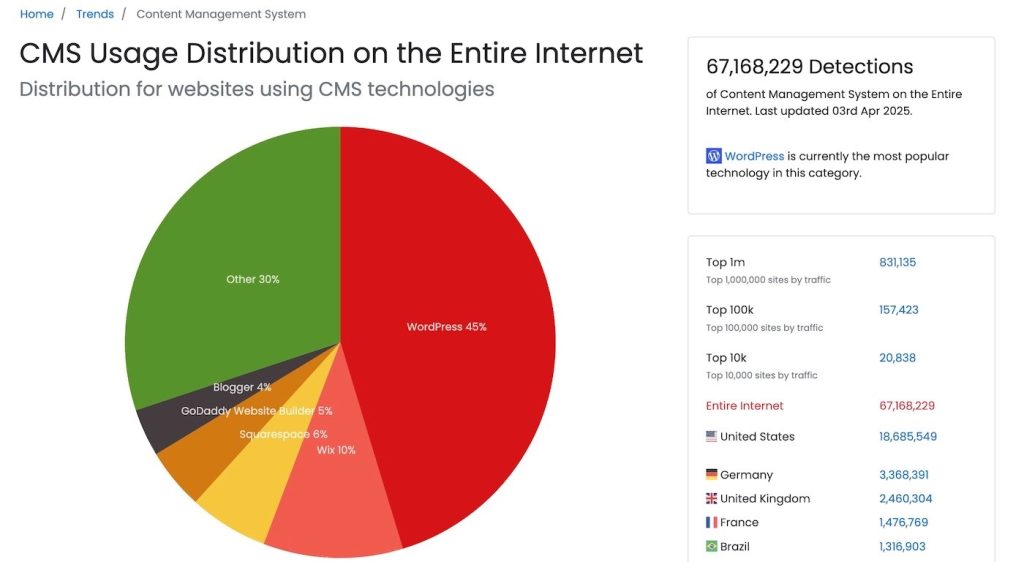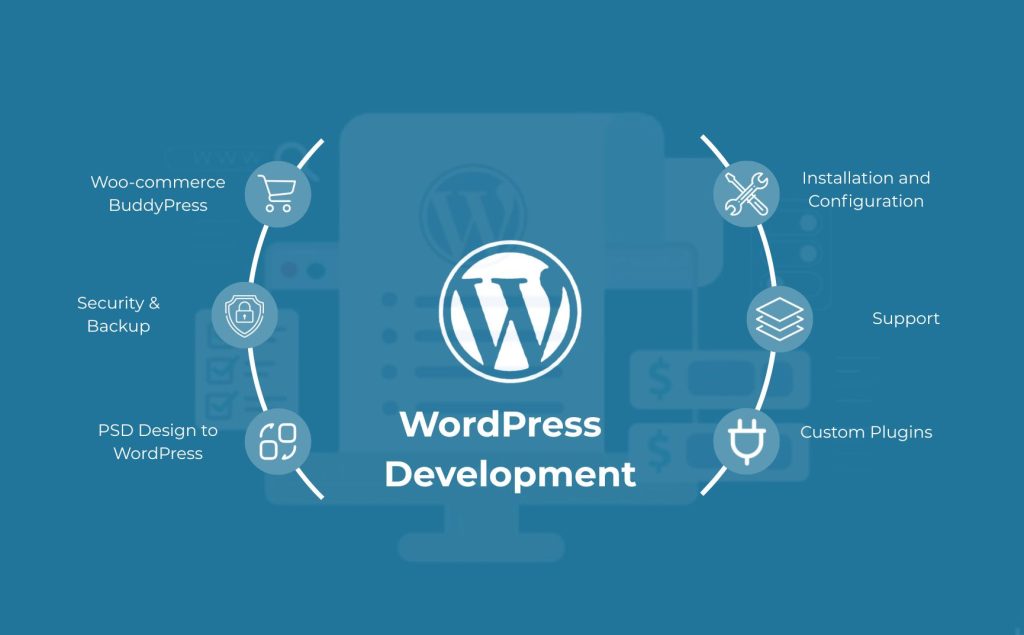It’s striking to witness WordPress’s transformation from a humble blogging platform to the engine behind over 43.4% of all websites as of April 2025. With more than 500 million sites possibly using it and a commanding 61% share of the CMS market, WordPress has evolved into a key pillar of modern internet infrastructure. How has WordPress transformed from a blogging tool into a digital infrastructure backbone?

WordPress has evolved into the most dominant content management system (CMS) on the internet. As of April 2025, WordPress powers 43.4% of all websites globally, according to W3Techs, and commands over 61% of the CMS market share.
This surpasses its nearest competitors by a wide margin, Shopify holds just 4.8%, Wix 3.7%, Squarespace 2.3%, Joomla 1.5%, and Drupal 0.8%. WordPress has grown into a vast ecosystem supporting over 500 million websites by some estimates, encompassing blogs, government portals, e-commerce platforms, media publications, and enterprise websites.
Its reach extends further through WordPress.com (a commercial hosting service owned by Automattic), and tens of thousands of themes, plugins, and integrations that enable extensibility and scale.
BuiltWith reports that more than 30 million websites actively use WordPress within its 70-million-website tracking pool. Furthermore, WordPress.org offers over 60,000 free plugins, while major companies such as The New York Times, Sony Music, and BBC America rely on the platform.
Josepha Haden Chomphosy, Executive Director, WordPress Project asserts: “WordPress succeeds not because it belongs to one person or one company, but because it belongs to everyone.”
From 0.8% to 43%: The transformation of a blogging tools into a modern internet infrastructure
In its early years, WordPress represented less than 1% of the internet. The platform’s market share has grown steadily for two decades, rising from 0.8% in the mid-2000s to 43.4% in 2025.
The open-source nature of WordPress Core (WordPress.org) empowered developers and users to freely adapt, improve, and deploy the CMS across a range of use cases—from blogs and corporate websites to e-commerce platforms and enterprise portals.
As of 2025:
- Over 500 million websites may be using WordPress in some form.
- W3Techs attributes 43.4% of websites to WordPress, with 61.2% CMS market share.
- BuiltWith tracks approximately 30 million WordPress sites in a 70 million domain sample set.
- Netcraft reports 1.19 billion websites in total as of March 2025.

Commercialisation vs open source ethics
The WordPress dispute reflects a broader trend across open-source ecosystems. As major platforms like WordPress, Kubernetes, and Linux underpin enterprise systems, commercial interests increasingly shape their trajectories.
In WordPress’s case, the lines between open-source community development and corporate monetisation are becoming more contentious. Automattic funds full-time contributors but also controls major components like Jetpack and WooCommerce. Critics argue that this gives Automattic disproportionate influence, despite the project’s nominal decentralisation.
Meanwhile, companies like WP Engine, GoDaddy, and Elementor generate significant revenue from WordPress products without formal governance roles—raising the issue of shared responsibility for the platform’s sustainability.
The WordPress ecosystem: Components and stakeholders
The WordPress ecosystem is both open-source and commercial. It includes a complex network of code contributors, hosting companies, commercial vendors, and service providers. The main components are:
1. WordPress Core (WordPress.org)
This is the free, open-source CMS software. It is maintained by a community of contributors overseen by volunteer teams, with oversight from lead developers. The codebase is licensed under the GNU General Public License (GPL), which enables anyone to use, modify, and distribute it freely.
2. Automattic
Founded by Matt Mullenweg (also the co-creator of WordPress), Automattic is the for-profit company behind WordPress.com. It provides paid services including hosting, premium themes, plugins (such as WooCommerce), and enterprise support. Automattic plays a pivotal role in funding contributors to WordPress Core and is often seen as the commercial steward of the project.
3. WP Engine
WP Engine is a major managed WordPress hosting provider. Though not affiliated with WordPress.org or Automattic, it hosts millions of WordPress sites and supports developers through its Genesis Framework and other developer tools. The company was valued at over $1 billion following private equity investment from Silver Lake.
4. Hosting Providers
Numerous web hosts offer WordPress-optimised services. Key players include Bluehost, SiteGround, Kinsta, and DreamHost. Some are officially recommended by WordPress.org; others operate independently with proprietary optimisations.
5. Plugins and Themes Marketplace
The WordPress Plugin Directory offers more than 60,000 free plugins. Commercial plugin and theme developers—such as Yoast, Elementor, and ThemeForest vendors—form a major part of the ecosystem, generating substantial revenue and supporting product innovation.
6. The WordPress Community
A global community of developers, translators, marketers, and users contributes to WordPress. Local WordCamps, meetups, and the Five for the Future initiative are examples of how the community sustains itself through volunteerism and corporate sponsorships.
Strategic significance in global digital infrastructure
WordPress is more than a CMS—it is now a foundational layer of the internet’s digital infrastructure. This gives the platform strategic significance in several areas:
1. Digital sovereignty and localisation
Governments and public institutions increasingly rely on open-source CMS solutions to maintain digital sovereignty. WordPress’s GPL licensing and localisation support make it suitable for public service websites in multilingual environments.
2. SME digital enablement
Millions of small businesses globally use WordPress to create and manage their online presence. With themes, page builders, and e-commerce plugins like WooCommerce, even non-technical users can build competitive websites.
3. Enterprise use
Although WordPress started as a blogging tool, it is now used by large organisations including The New York Times, Microsoft, and NASA. Managed WordPress services tailored to enterprise security, scalability, and compliance are enabling deeper adoption.
4. Decentralised innovation
WordPress enables decentralised innovation through its plugin and theme architecture. Developers can create independent solutions without core changes, fostering a low-friction, modular development environment.

Legal disputes: Automattic vs WP Engine
The WordPress ecosystem, though built on the principles of openness and collaboration, has faced increasing tension as commercial interests expand. A major point of contention emerged in 2024 between Automattic, the for-profit company founded by WordPress co-creator Matt Mullenweg and WP Engine, one of the largest managed WordPress hosting providers.
Background
The conflict centres around the usage of the “WordPress” and “WooCommerce” trademarks—both of which are owned by Automattic and managed under the WordPress Foundation’s guidelines. In mid-2024, Automattic accused WP Engine of:
- Using the “WordPress” and “WooCommerce” marks in domain names, URLs, marketing campaigns, and product branding without explicit permission.
- Violating longstanding community guidelines which discourage the use of “WordPress” in top-level domain names to avoid brand confusion.
- Misrepresenting affiliation with the core WordPress project and Automattic’s products, particularly in the WooCommerce plugin ecosystem.
WP Engine’s response
WP Engine rejected Automattic’s claims and positioned itself as a significant contributor to the WordPress ecosystem. It argued that:
- The terms “WordPress” and “WooCommerce” have become industry-standard descriptors for sites and services built using the platform, and thus should be treated as generic rather than proprietary in commercial use.
- WP Engine has invested millions of dollars into supporting developers, funding plugin innovation, and participating in initiatives like Five for the Future, a programme encouraging companies to contribute 5% of their resources to the WordPress project.
- Automattic’s actions were an attempt to monopolise control over the commercial direction of WordPress, despite the platform’s decentralised and community-driven identity.
Escalation to legal action
Following a breakdown in direct negotiations, WP Engine filed a lawsuit in a U.S. federal court in October 2024, alleging:
- Unfair competition under the Lanham Act.
- Interference with business relationships, including the removal or de-prioritisation of WP Engine’s plugins from the WordPress Plugin Directory.
- Trademark abuse, contending that Automattic’s enforcement actions were excessive and lacked transparency or due process.
Preliminary injunction
In December 2024, a U.S. District Court in California issued a preliminary injunction in favour of WP Engine. The court acknowledged that:
- WP Engine demonstrated a likelihood of success on the merits of its claims regarding business interference and reputational harm.
- Automattic’s unilateral actions—such as attempting to remove WP Engine-affiliated plugins and restricting contributor access—could undermine the credibility of the open-source governance model.
As part of the injunction, the court ordered Automattic to:
- Reinstate WP Engine’s access to WordPress.org repositories, forums, and developer tools.
- Halt efforts to delist or penalise WP Engine’s plugins and themes without proper community-led review processes.
- Cease public statements asserting trademark infringement until legal review is completed.
Industry impact and Governance Implications
This legal dispute has sparked wider conversations within the WordPress and open-source communities about the balance of power between corporate stakeholders and community contributors. Many developers and businesses expressed concern over:
- The lack of a neutral body to mediate conflicts within the WordPress project.
- The blurring of lines between Automattic’s commercial interests and the stewardship of WordPress as a public resource.
- The potential for fragmentation, where commercial providers might fork the platform or develop separate standards to avoid conflicts with trademark enforcement.
Challenges and the road ahead
As the platform matures, it faces several challenges:
- Security: Its popularity makes it a target for attackers. Ongoing investment in secure coding practices and threat detection is vital.
- Performance: New competition from headless CMSs and static site generators (like Ghost, Hugo, and Netlify CMS) pressures WordPress to improve speed and modularity.
- Governance: As commercial influence grows, community governance models may need formalisation. Recent legal disputes highlight the risks of ad hoc conflict resolution.
- AI integration: With the rise of AI-driven content creation, WordPress is adapting via plugins and integrations with tools like OpenAI, Jasper, and Copilot—but cohesive platform-level strategies remain in early stages.
WordPress at a strategic crossroads
The WordPress ecosystem remains one of the most successful open-source software stories in history. With over 43% of the internet running on it, WordPress represents not just a technical achievement but a case study in distributed collaboration, commercial coexistence, and digital empowerment.
However, the recent legal conflict between Automattic and WP Engine underscores a maturing ecosystem grappling with governance, fairness, and sustainability. For stakeholders—whether enterprise users, governments, SMEs, or developers—these dynamics will shape the platform’s future relevance.
WordPress’s continued dominance will depend on its ability to balance decentralisation with accountability, foster innovation while preserving core principles, and integrate commercial ambition with community trust.

Dinis Guarda is an author, academic, influencer, serial entrepreneur, and leader in 4IR, AI, Fintech, digital transformation, and Blockchain. Dinis has created various companies such as Ztudium tech platform; founder of global digital platform directory openbusinesscouncil.org; digital transformation platform to empower, guide and index cities citiesabc.com and fashion technology platform fashionabc.org. He is also the publisher of intelligenthq.com, hedgethink.com and tradersdna.com. He has been working with the likes of UN / UNITAR, UNESCO, European Space Agency, Davos WEF, Philips, Saxo Bank, Mastercard, Barclays, and governments all over the world.
With over two decades of experience in international business, C-level positions, and digital transformation, Dinis has worked with new tech, cryptocurrencies, driven ICOs, regulation, compliance, and legal international processes, and has created a bank, and been involved in the inception of some of the top 100 digital currencies.
He creates and helps build ventures focused on global growth, 360 digital strategies, sustainable innovation, Blockchain, Fintech, AI and new emerging business models such as ICOs / tokenomics.
Dinis is the founder/CEO of ztudium that manages blocksdna / lifesdna. These products and platforms offer multiple AI P2P, fintech, blockchain, search engine and PaaS solutions in consumer wellness healthcare and life style with a global team of experts and universities.
He is the founder of coinsdna a new swiss regulated, Swiss based, institutional grade token and cryptocurrencies blockchain exchange. He is founder of DragonBloc a blockchain, AI, Fintech fund and co-founder of Freedomee project.
Dinis is the author of various books. He has published different books such “4IR AI Blockchain Fintech IoT Reinventing a Nation”, “How Businesses and Governments can Prosper with Fintech, Blockchain and AI?”, also the bigger case study and book (400 pages) “Blockchain, AI and Crypto Economics – The Next Tsunami?” last the “Tokenomics and ICOs – How to be good at the new digital world of finance / Crypto” was launched in 2018.
Some of the companies Dinis created or has been involved have reached over 1 USD billions in valuation. Dinis has advised and was responsible for some top financial organisations, 100 cryptocurrencies worldwide and Fortune 500 companies.
Dinis is involved as a strategist, board member and advisor with the payments, lifestyle, blockchain reward community app Glance technologies, for whom he built the blockchain messaging / payment / loyalty software Blockimpact, the seminal Hyperloop Transportations project, Kora, and blockchain cybersecurity Privus.
He is listed in various global fintech, blockchain, AI, social media industry top lists as an influencer in position top 10/20 within 100 rankings: such as Top People In Blockchain | Cointelegraph https://top.cointelegraph.com/ and https://cryptoweekly.co/100/ .
Between 2014 and 2015 he was involved in creating a fabbanking.com a digital bank between Asia and Africa as Chief Commercial Officer and Marketing Officer responsible for all legal, tech and business development. Between 2009 and 2010 he was the founder of one of the world first fintech, social trading platforms tradingfloor.com for Saxo Bank.
He is a shareholder of the fintech social money transfer app Moneymailme and math edutech gamification children’s app Gozoa.
He has been a lecturer at Copenhagen Business School, Groupe INSEEC/Monaco University and other leading world universities.









